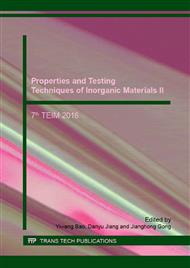p.8
p.13
p.18
p.23
p.28
p.33
p.38
p.43
p.50
New Characterization Method of Hot Metal Penetration Resistance for Blast Furnace Carbon Blocks
Abstract:
The main causes for deterioration of carbon blocks are due to the penetration and dissolution of hot metal against pores and surfaces. The active national standard GB/T 24201-2009 can only judge the hot metal dissolution, but the penetration of hot metal during test has been neglected. On the basis of national standard, a new measurement and characterization method is proposed. The study shows that with the help of back-scattered electron detect technology combined with statistical analysis, the penetration depth of hot metal could be quantitative evaluated, which could provide a reference for optimize the production of blast furnace refractories.
Info:
Periodical:
Pages:
28-32
Citation:
Online since:
January 2017
Authors:
Price:
Сopyright:
© 2017 Trans Tech Publications Ltd. All Rights Reserved
Share:
Citation:


